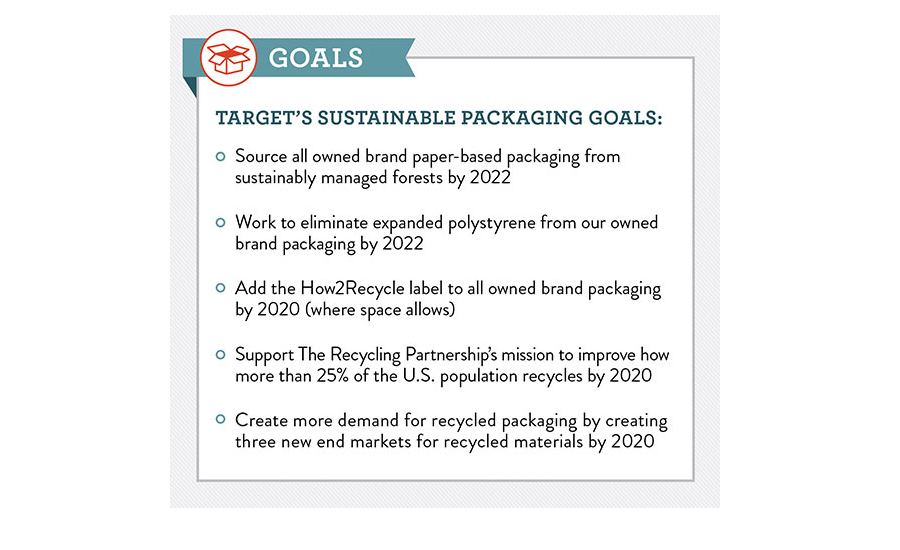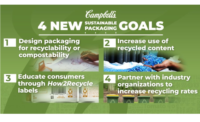Target announces packaging sustainability goals

Furthering Target’s commitment to sustainability, the retailer just this week announced new goals that complement its existing product goals and look at the packages those products come in.
“We know our guests pay attention to packaging and its impact on the environment,” says Jennifer Silberman, Target’s chief sustainability officer. “When we provide them with thoughtfully designed, environmentally friendly packaging, we’re able to help them take another step toward sustainable living.” Our work began back in 2013 with our first packaging goal: to enhance at least 50 of our owned brand packages to be more sustainable by 2016. Our teams exceeded it, serving up 160 enhanced packaging designs that used fewer materials and more recycled content, and were recyclable themselves.
Target’s five new sustainable packaging goals reflect guest expectations, business priorities, industry challenges and areas the retailer can drive the most change. Goals include:
- Source all owned brand paper-based packaging from sustainably managed forests by 2022
- Work to eliminate expanded polystyrene from our owned brand packaging by 2022
- Add the How2Recycle label to all owned brand packaging by 2020 (where space allows)
- Support The Recycling Partnership’s mission to improve how more than 25% of the U.S. population recycles by 2020
- Create more demand for recycled packaging by creating three new end markets for recycled materials by 2020
“As a leader in design, we can use our expertise to create more sustainable packaging options for our guests and help deliver products that are both better-for-you and better for the environment,” says Silberman. “With the power of Target’s team and our scale as one of the country’s largest retailers, we hope to be a catalyst for change across the industry – aiming for the day when all packaging will be recyclable, and leading the way to a packaging-waste-free world.”
Here is a closer look at each goal:
Eliminating expanded polystyrene
Polystyrene, or foam packaging, is a challenge in many ways. It’s a pain to recycle, both for our guests and our distribution centers. It’s also a major cause of ocean plastic contamination—by 2030, predictions say the oceans could have more plastic than fish! And when not produced using safe methods, it can be harmful to manufacturing workers’ health. So as part of our chemical policy, we’ll work closely with our suppliers and other partners to find better options for our packaging, taking into account the performance, cost and availability of materials.
Sourcing from sustainably managed forests
It’s an important part of the forest products policy we unveiled earlier this month. With the help of our vendors and other partners, we’ll work to understand the origin of the raw materials that go into our paper-based packaging and improve the sustainability of forests where the timber used to produce them was grown. We’re kicking off the work with a focus on six of our owned brands: Spritz, Pillowfort, Cat & Jack, up & up, Smith & Hawken and Threshold.
Adding the How2Recycle label
GreenBlue’s How2Recycle label is an industry standard that lets consumers know exactly how to recycle a particular piece of packaging. As a member of the Sustainable Packaging Coalition, Target’s already got it on 1,700+ of our product packages—more than any other retailer. We’ll keep up the momentum by continuing to look for ways to place the label on more of our owned brand packaging whenever space allows.
Supporting The Recycling Partnership
Guests tell us they love to recycle, so as the first retailer to join The Recycling Partnership, we’ll make it easier by increasing access to the resources they need. One big example? Studies show just 53 percent of the U.S. population have recycling as a standard service, and even fewer have cart-based programs. Our investment will bring curbside recycling to more underserved communities—increasing recycling and making more recycled raw materials available for packaging.
Creating more demand for recycled packaging
The recycling industry is struggling to help consumers understand how and why recycling is so important. So we’ll champion the cause by advancing the idea that all packaging will be recyclable one day, making the process easier for all. We’ve joined two industry efforts to help: The Material Recovery Facility of the Future, a project working toward a vision that all packaging can be recycled. And Beyond 34, a project focused on demonstrating and sharing the best practices to raise the U.S. recycling rate beyond the current rate of 34 percent.
Target will report progress of its sustainable packaging goals annually in its annual Corporate Social Responsibility Report.
Looking for a reprint of this article?
From high-res PDFs to custom plaques, order your copy today!






